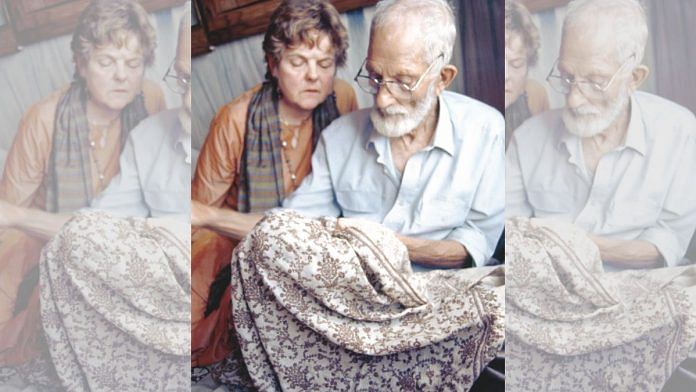New Delhi: Artisans of North India carry a picture of Jenny Housego with them. The woman from England may seem like an odd choice but she has become somewhat of a patron saint for the weavers and embroiders— reviving their arts and giving them a piece of the profits.
Housego moved to India in 1989 and was immediately taken by the country’s
bright colours, the warmth of its weavers and the richness of Indian textiles. The textile historian, author and entrepreneur found her life’s purpose in this country, fostering a relationship with the local artisans and falling in love with their carpets, and later shawls.
Housego’s current focus is Kashmir Loom, which she co-founded in 2000 alongside Asaf Ali and his brothers. Through the venture, she has redefined the traditional embroidered shawls from the Kashmir Valley.
“When I first came to India, I thought it was a strange place and it would take some time for me to get my feet on the ground. But soon I realised that my feet were firmly placed on the ground and I never wanted to leave this country at all,” Housego recalled.
She was speaking with journalist Maya Mirchandani in an online event, Meet the Artist, organised by JD Centre of Art (JDCA) in collaboration with the India International Centre on 13 May. Housego poignantly reminisced about her travels and work in documenting local handicrafts and textiles across Asia over the decades.
Also Read: Why India’s critical textile sector, employing 4.5 crore people, is facing challenges
An introduction to Asia
After completing her education in London, Housego travelled extensively across Iran by road, covering the length and breadth of the country, meeting its tribal communities and discovering their work.
She was trailing her husband David Housego, a journalist. She was surprised by the bright and colourful tribal rugs which she saw. She noted that they were unfortunately limited to specific regions and did not have a big market.
Housego wanted to give the nomadic tribes a direct avenue to upscale their business. This led to the formation of the Rug Society. Through it, she held an exhibition of 25 tribal horse blankets because she found them so “beautiful and unusual”.
“They were like modern art,” she said.
During her time in Iran, Housego dived into the wonders of Asia. She proved to be “quintessentially Desi”, Mirchandani suggested.
Also Read: Vyjayanthimala to Rekha to ‘Kasturba’: Bhanu Athaiya marked before-after in Indian costume design
India was a homecoming
David’s posting as a South Asia correspondent in New Delhi introduced Housego to the vibrancy of Indian culture. She and social worker, Anne Shankar travelled across Punjab and Haryana and worked closely with women artisans in these states who were weaving durries (carpets).
In 1992, she launched her first textile company with her husband, Shades of India, in an effort to bring European aesthetics to Indian textiles. On one of her trips to Uttar Pradesh, Housego discovered an interesting applique work on organdy, which was sold locally in markets. Inspired by this, she developed a collection of duvet covers featuring the fabric.
“To further make sure this craft received the attention it deserved, Jenny also set up workshops in Haryana, as Shades of India, taught young women how to sew and do the applique,” said Mirchandani.
Housego chanced upon Asaf Ali in 1998 while exploring Persian carpets. Their meeting inspired “a new direction” — she wanted to include shawls in her work. This was the first step towards Kashmir Loom.
One of their most popular products was inspired by an NID student’s idea of incorporating metallic yarn in the weaves. Habibullah Phalguru, the renowned Kashmiri Sozni embroiderer was also a strong influence.
Today, Kashmir Loom is a successful brand and even exports its products overseas.
What stood out about Housego’s work over the years, was not just the way she revived Indian products or designs, it was the way she immersed herself into the worlds of these artisans, allowing them to share their work with her on their own terms, despite the language barrier.
“I’ve been terribly lucky in that regard. I seem to have inspired so many people,” said Housego. “But they probably all just thought of me as a bossy lady when I first met them,” she joked.
Vice Chairman of JDCA and Designer Siddhartha Das, recalled his experience while documenting Housego’s work.
“I ate the most amazing food at the homes of these artisans in North India and was treated so well [when they realised I was a friend of Housego], ” he said.
(Edited by Theres Sudeep)



